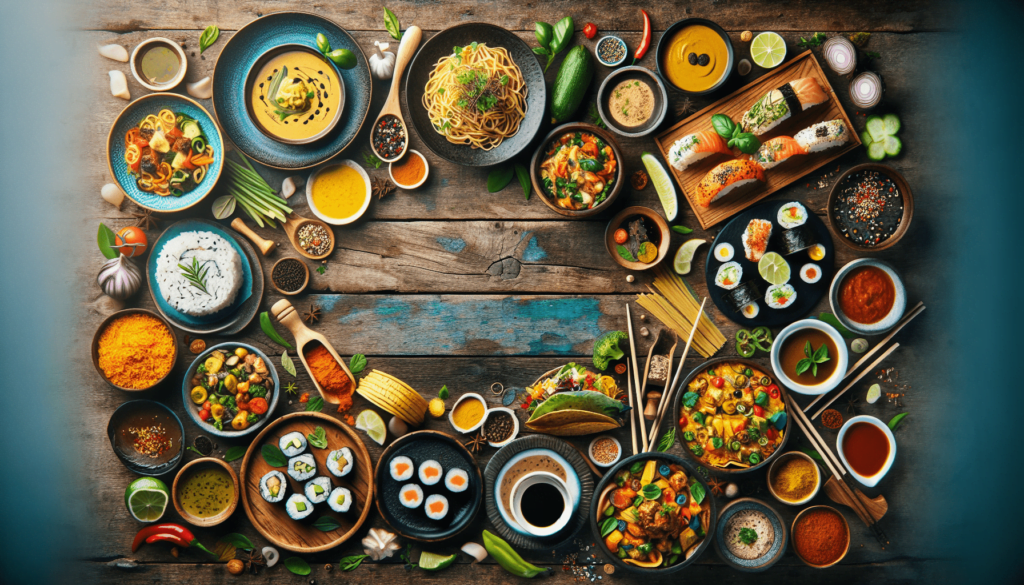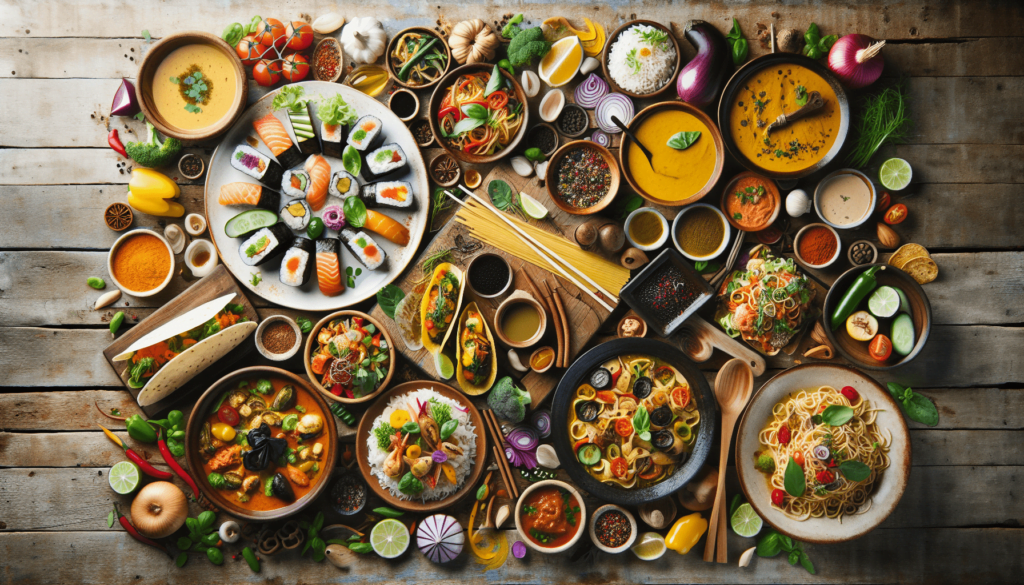Welcome to “Experiencing Culinary Delights from Around the Globe!” In this vibrant journey, you will discover a taste of the world through an exploration of various international cuisines, grounded in historical context and enriched by current trends. Whether it’s the aromatic spices of India, the delicate pastries of France, or the sizzling barbecue of Texas, each bite tells a unique story.
This article aims to provide you with an in-depth understanding of the key components, diverse methods, and cultural significance of these global culinary treasures, all while offering compelling examples and balanced perspectives. Buckle up your taste buds; we’re about to embark on a flavorful adventure that will broaden your culinary horizons and leave you craving for more! Have you ever wondered what it means to truly experience the culinary delights from around the globe? Imagine tasting the spicy, aromatic dishes of India one night, then savoring the delicate, intricate flavors of Japan the next. Your taste buds travel the world, even if your feet are still firmly planted at home.

Table of Contents
Overview
In our increasingly globalized world, experiencing international cuisine has become more accessible than ever. This article aims to take you on a gastronomic journey through various cultures, exploring the historical context, current trends, and future implications of global cuisine. By the end, you’ll not only have a newfound appreciation for diverse culinary traditions but also practical tips to infuse these flavors into your own kitchen.
Historical Context
Food is a vital element of cultural heritage, shaping identities and connecting generations. We can trace many culinary traditions back to their roots, discovering how they’ve evolved over time.
The Beginnings of Global Cuisine
The spice trade, which flourished between the 15th and 17th centuries, opened the doors to the intermingling of culinary practices between the East and the West. Spices like pepper, cinnamon, and cloves were so valued that they were used as currency. European explorers brought back these exotic spices, which quickly became staples in Western kitchens.
Colonial Influence
Colonialism further spread culinary traditions. British control in India led to the birth of Anglo-Indian cuisine, giving the world iconic dishes like Chicken Tikka Masala. Likewise, French colonialism in Vietnam resulted in the beloved Banh Mi, a Vietnamese baguette sandwich filled with an array of flavors.
Current Trends
Fast forward to today, global cuisine isn’t just a luxury—it’s a way of life. From food trucks to high-end restaurants, diverse culinary influences are everywhere.
Fusion Cuisine
Fusion cuisine is all the rage these days. Chefs are blending ingredients and techniques from different cultures to create unique, delicious dishes. Think sushi burritos, a mix of Japanese and Mexican cuisine, or Korean tacos, where traditional Korean BBQ meets the classic Mexican taco. These fusion dishes reflect our interconnected world.
Farm-to-Table Movement
Locally sourced ingredients are now in vogue, with chefs and home cooks alike emphasizing sustainable and seasonal eating. This trend transcends borders, with each culture bringing its spin. In Italy, it’s known as “cucina povera,” focusing on simple, fresh ingredients. In Japan, Kaiseki dining epitomizes seasonality and meticulous presentation.
Street Food Revolution
Street food, once considered lowbrow, is enjoying a renaissance. Street vendors bring authenticity to global cuisine, offering everything from Thai satay skewers to Mexican elote (grilled corn). The rise of street food markets and festivals highlights the cultural wealth and culinary diversity available to us.
Key Concepts and Definitions
To fully appreciate global cuisine, it’s essential to understand some of its key concepts and terminology.
Seasonality
Seasonality refers to the use of ingredients during their peak growing season. Seasonal ingredients are fresher, tastier, and often more nutritious. For instance, tomatoes in Italy are best enjoyed in the summer when they are ripe and full of flavor.
Umami
The fifth taste sensation, umami, is a savory flavor found in foods like soy sauce, Parmesan cheese, and tomatoes. Discovered by Japanese chemist Kikunae Ikeda, umami is a fundamental concept in global cuisine, adding depth and richness to dishes.
Fermentation
Fermentation is a traditional preservation method that also enhances flavors. Cultures worldwide utilize this technique, from Korean kimchi to German sauerkraut. Fermented foods are not only delicious but also beneficial for gut health.

Break It Down: Exploring World Cuisines
Let’s break down global cuisine into several regions to better understand their unique culinary traditions. We’ll examine two major examples to illustrate the depth and richness available.
Asian Cuisine
Asia boasts a vast array of culinary traditions, from the fiery curries of Thailand to the refined sushi of Japan.
Example 1: Indian Cuisine
Indian cuisine is a melange of rich flavors and vibrant colors. Distinctive spices like turmeric, cardamom, and cumin are the backbone of its dishes. Take a classic, Butter Chicken: marinated in a yogurt-spice mixture and simmered in a rich tomato sauce, it embodies the complexity of Indian flavors.
Example 2: Japanese Cuisine
Japanese cuisine emphasizes harmony between ingredients, often showcasing seasonality and simplicity. Sushi, a quintessential Japanese dish, combines fresh fish, vinegared rice, and various toppings. The precision and artistry involved highlight Japan’s dedication to culinary excellence.
European Cuisine
European cuisine is diverse, ranging from the hearty stews of Eastern Europe to the delicate pastries of France.
Example 1: Italian Cuisine
Italian cuisine is cherished for its simplicity and focus on quality ingredients. Pasta, a staple, can be enjoyed in numerous forms. Take Spaghetti Aglio e Olio: made with just garlic, olive oil, and chili flakes, this dish exemplifies how simple ingredients can create a memorable meal.
Example 2: French Cuisine
French cuisine is often considered the epitome of culinary arts. Dishes like Coq au Vin, a chicken stew braised in red wine, showcase slow cooking techniques and rich flavors that define traditional French cooking.
American Cuisine
American cuisine may be young, but it has absorbed and adapted diverse culinary traditions.
Example 1: Southern Cuisine
Southern cuisine reflects African, Native American, and European influences. Fried chicken, mac ‘n’ cheese, and collard greens are staples, creating a hearty, comforting food landscape.
Example 2: New American Cuisine
New American cuisine focuses on innovation, blending traditional American dishes with global influences. Think of a Kobe beef cheeseburger—Japanese beef meets a classic American burger.
Compare Different Points of View
Exploring global cuisine requires looking at different cultural perspectives on cooking and dining.
| Region | Approach to Dining | Common Ingredients | Typical Cooking Methods |
|---|---|---|---|
| Asia | Communal eating, focus on balance | Rice, spices, soy products | Stir-frying, steaming, grilling |
| Europe | Multi-course meals, seasonal focus | Olive oil, dairy, bread | Baking, braising, roasting |
| America | Fusion cuisine, large portions | Corn, beef, poultry | Grilling, frying, barbecuing |
Impact Assessment
These diverse approaches impact not only how we cook and eat but also our understanding of nutrition and community. For example, Asian cuisines’ focus on balance often leads to healthier eating habits, while American cuisine’s embrace of innovation fosters creativity in the kitchen.
Future Directions and Implications
The future of global cuisine is exciting, marked by technological advancements and a heightened sense of sustainability.
Predictions
Expect to see more plant-based options across various cuisines as environmental concerns grow. Lab-grown meats and plant-based substitutes are becoming more refined and tasty, making it easier to reduce our carbon footprint without sacrificing flavor.
Implications
As we embrace global cuisine, it’s crucial to respect and preserve traditional culinary practices. The rise of culinary tourism and cooking shows is a double-edged sword: while they introduce more people to diverse foods, they can also lead to the oversimplification and commercialization of these rich traditions.
Conclusion
To sum up, experiencing culinary delights from around the globe opens up a world of flavors, traditions, and history. Whether it’s the rich, spicy dishes of India or the elegant simplicity of Japanese cuisine, each bite tells a story. So, what’s stopping you from exploring the culinary world from your kitchen? Dive in, experiment, and let your taste buds travel.
What global dish are you excited to try next? Leave a comment and let’s continue our culinary adventure together!
Stay tuned for more articles that will guide you through even more delicious global cuisines and culinary tips. Until then, happy cooking and adventurous eating!
